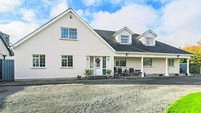Barrow boat trip affords blissful peace

'We were on Cliff Reid’s boat, which started on the three-hour trip at Athy harbour and made its way in the direction of the Horse Bridge' Photo: Carmel Whelan
THE redevelopment of Emily Square has received unqualified praise and has given the people of Athy enormous pride in their town.
I have never before noted such widespread praise as greeted the re-opening of the town’s square. Well done to everybody involved in this major project.
During the week, I took a trip on the Barrow line as far as Levitstown Mill with members of my extended family. We were on Cliff Reid’s boat, which started on the three-hour trip at Athy harbour and made its way in the direction of the Horse Bridge.
As we travelled at approximately 5mph I was reminded of the history of the Canal and of the tremendous improvements, economically and socially, it once brought to the town of Athy. The canal was extended to Athy in 1791, just seven years before the armed rebellion, which witnessed the killing of thousands of Irish men and women.
Our boat travelled under the Horse Bridge, which is the only such bridge in Ireland and was constructed to allow horses pulling the early canal boats to cross from the Grand Canal to the River Barrow.
We then entered the Ardreigh Canal, which is approximately 250 yards long, passing on the right the weir which connects two separate parts of Lords Island.
The island, which has all the attributes of a nature reserve, has yet to be so designated in the County Kildare Development Plan. I have previously submitted a request to Kildare County Council to do so, without success.
Hopefully, the council’s next draft county development plan will include a proposal to include Lords Island as a nature reserve. I saw somewhere recently a claim that Lords Island was so named as a result of some religious connection.
In fact, the island was named after its owner in the 19th century who was a local solicitor and an agent for the Duke of Leinster.
Before exiting the Ardreigh Canal, we passed under the handsome drawbridge which once gave access to Haughton’s Mill, later owned by the Hannon family on the island. The mill workers produced the Lilywhite flour, which was sold in white bags and is believed to have given the Kildare County Gaelic football team the nickname ‘the Lilywhites’.
As we exited Ardreigh lock the canal, and the River Barrow rejoins each other for the next one and a half miles. Afterwards both separated again for approximately two miles before reaching the Levitstown canal. On the way we passed Bunberry’s weir, a favourite swimming place in my school days, although truth to tell I didn’t learn to swim until I was in my 30s and living in Sutton, Dublin.
Work on the Barrow navigation started in 1759 and was completed on reaching Athy in 1791. It is only in recent years that the recreational amenity value of the canal on either side of Athy has been appreciated by the general public.
I was conscious of this as Cliff Reid gave an excellent commentary on different aspects of the canal flora and fauna. I recalled the local fishermen led by the late Nicholas Cahill and John Shaughnessy, who established fishing stands on the River Barrow.
The pike, perch, roach and eel which populate the Barrow, were most sought-after water trophies. As our boat almost silently cut through the canal water I was vividly reminded of the canal’s flora.
The canal cuttings made by the hands of men almost 250 years ago have largely. due to limited use. become evergreen with reeds and bull rushes. The boating channel has become narrower and requires attention.
I understand that the canal section extending into Co Carlow is the subject of a planning appeal by Waterways Ireland because of objections relating to the development of the canal towpath.
The canal’s fauna passed me by almost unnoticed except for the pair of swans with their young cygnets sitting on their nest just past Bunberry’s weir. The stately elders and their youngsters were not disturbed by the slowly passing boat, proof if required that the sacred birds of the Children of Lir have lived in the same spot for quite some time.
Athy men played an important part in the development of the canal system with several bye traders boats owned by Athy families. The last such boat, which carried the prefix B was built for James Hughes of Athy in 1937. It carried the number 113B. Athy Harbour, I always understood, was the Grand Canal’s hotel but I am now informed that it was a private hotel. The original owner has not yet been identified.
It was from here that passenger boats set off for Dublin at 5 o’clock in the morning on a thirteen-hour journey. The boat for Athy left Dublin at 5am and reached the south Kildare town at 6pm. The cost of a state cabin per passenger on the canal passenger boats in the early years was 8 shillings and 1½ pence, while what is called the common cabin cost 4 shillings and 5½ pence per passenger.
Our trip of almost three hours finished as we disembarked at what was once known as Athy Harbour, which lies directly behind the Courthouse. It was a wonderfully peaceful trip enlivened by Cliff Reid’s informative commentary on different aspects of canal and River Barrow life. The boat which had been idle for almost two years while in the ownership of Kildare County Council is now owned by local man Cliff who has a similar boating business in Kilkenny city.
The Athy boat trip can be an important recreational asset for locals and visitors alike and especially so when the Shackleton Museum opens. Best of luck to Cliff and his team who deserve every support which can possibly be afforded by the people of Athy. After all a boat trip on the Barrow line affords blissful peace in placid surroundings.
I was saddened to learn of the death of another classmate of mine, following so soon after Billy Browne’s death. Reggie Lalor was a classmate in the local Christian Brothers School until he left to join as a boarder student the Carmelite College in Moate, Co Westmeath. Tributes to Reggie on Facebook all describe him as a gentleman. That indeed he was.
He visited me in Naas Hospital during one of my many recent confinements in the former County hospital. Reggie’s public face, in more recent years, was as a member of the volunteers who assisted the Catholic clergy in services in St Michael’s Parish Church.
His work and that of his fellow volunteers might not have always received the thanks and appreciation of the local parishioners. Reggie will be sadly missed by his wife Liz and sons Derek and Aiden and extended family. To his family and friends, I extend my sincere sympathies. Ar dhéis Dé go raibh a anam.






